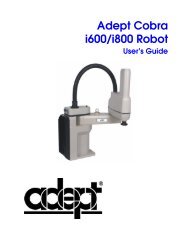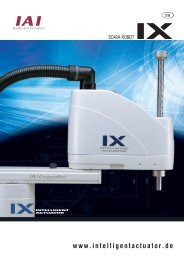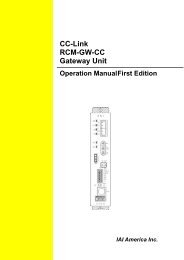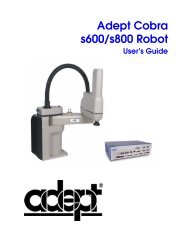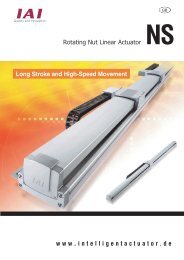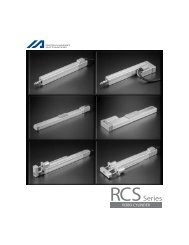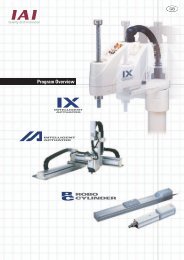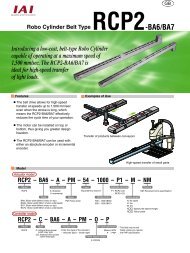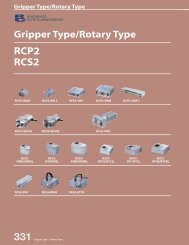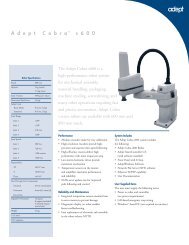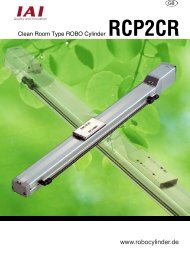Download Adept Cobra PLC600 User's Guide - pulsar.com.tr
Download Adept Cobra PLC600 User's Guide - pulsar.com.tr
Download Adept Cobra PLC600 User's Guide - pulsar.com.tr
Create successful ePaper yourself
Turn your PDF publications into a flip-book with our unique Google optimized e-Paper software.
Wiring the System<br />
User E-Stop Indication - Remote Sensing of E-Stop<br />
Two pairs of pins on the XUSR connector (pins 7, 20 and 8, 21) provide voltage-free<br />
contacts, one for each channel, to indicate whether the E-Stop chain, as described above,<br />
on that channel is closed. Both switches are closed on each of the redundant circuits in<br />
normal condition (no E-Stop). The user may use these contacts to generate an E-Stop for<br />
other equipment in the workcell. This output does NOT report status of “line E-Stop”<br />
input (see the section below for more information). The load on the contacts must not<br />
exceed 40VDC or 30VAC at a maximum of 1A.<br />
These voltage-free contacts are provided by a redundant, cyclically checked,<br />
positive-drive, safety relay circuit for EN-954-1 Category 3 operation (see Figure 4-13 on<br />
page 62 and Table 4-9 on page 60 for the customer E-Stop circui<strong>tr</strong>y).<br />
Line E-Stop Input<br />
The XUSR connector on the PLC Server contains a two-channel Line E-Stop input for<br />
workcell or other equipment emergency stop inputs. Generally, the customer E-Stop<br />
Indication contact outputs are used to cause an emergency stop in such external<br />
equipment. Thus, if one were to wire the same equipment’s outputs into the customer<br />
E-Stop input (that is, in series with the local robot’s E-Stop push buttons), a lock up<br />
situation can occur.<br />
The Line E-Stop input <s<strong>tr</strong>ong>com</s<strong>tr</strong>ong>es into the circuit at a point where it cannot affect the customer<br />
E-Stop indication relays and will not cause such a lock up situation. For any situation<br />
where two systems should be “cross-coupled”, for example, the customer E-Stop<br />
indication of one PLC Server is to be connected to the input of another PLC Server, the<br />
Line E-Stop input is the point to bring in the other PLC Server’s output contacts, see<br />
Figure 4-13 on page 62 for more information.<br />
Do not use the Line E-Stop for such devices as local E-Stop push buttons since their status<br />
should be reported to the outside on the local customer E-Stop indication output contact<br />
while the Line E-Stop inputs will not.<br />
Muted Safety Gate E-Stop Circui<strong>tr</strong>y<br />
Two pairs of pins on the XUSR connector (pins 5, 18 and 6, 19) provide connections for a<br />
safety gate designed to yield an E-Stop allowing access to the workspace of the robot in<br />
Manual mode only, not in Automatic mode. The E-Stop is said to be “muted” in Manual<br />
mode (see Figure 4-13 on page 62, Table 4-9 on page 60, and Table 4-10 on page 61 for the<br />
customer E-Stop circui<strong>tr</strong>y).<br />
The muted capability is useful for the situation where a shutdown must occur if the cell<br />
gate is opened in normal production mode, but you need to open the gate in manual<br />
mode. In muted mode, the gate can be left open for personnel to work in the robot cell.<br />
However, safety is maintained because of the speed res<strong>tr</strong>iction.<br />
CAUTION: If the cell gate must always cause a robot<br />
shutdown, do not wire the gate switch into the muted<br />
safety gate inputs. Instead, wire the gate switch contacts in<br />
series with the user E-Stop inputs.<br />
64 <s<strong>tr</strong>ong>Adept</s<strong>tr</strong>ong> <s<strong>tr</strong>ong>Cobra</s<strong>tr</strong>ong> <s<strong>tr</strong>ong>PLC600</s<strong>tr</strong>ong>/PLC800 Robot User’s <s<strong>tr</strong>ong>Guide</s<strong>tr</strong>ong>, Rev B



